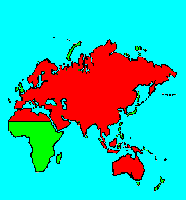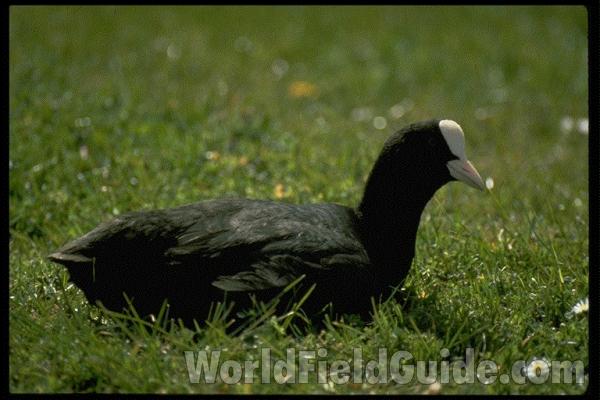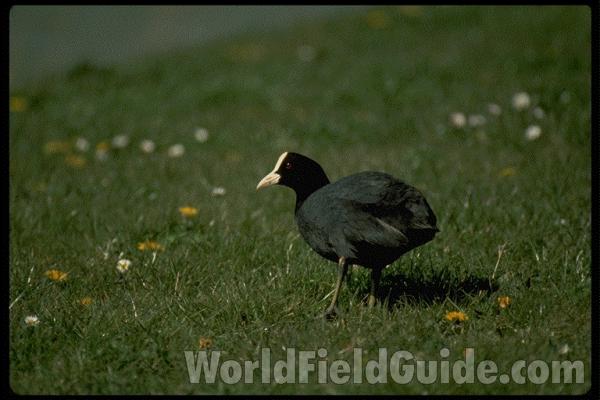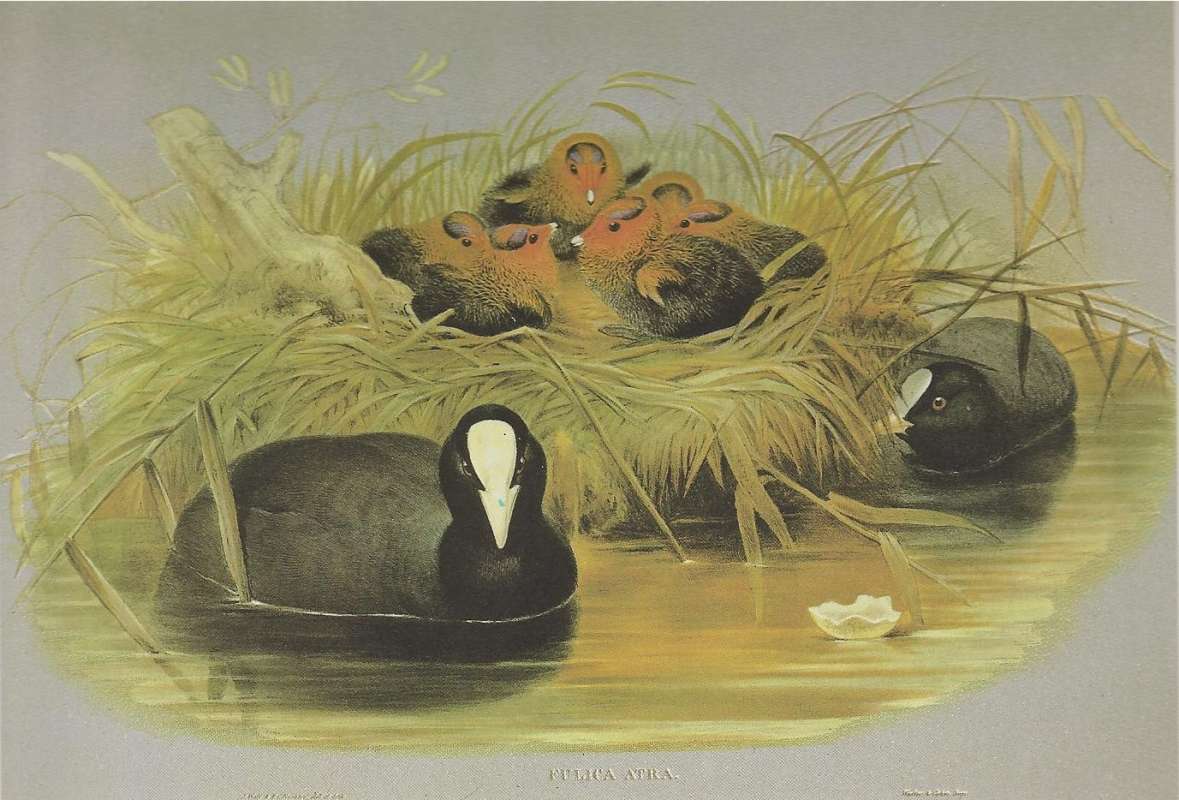SPECIES INFO
Old World Coot or Black Coot (Fulica atra) is found from Europe to the Orient and frequently further south. In the European areas this is found from southern Scandinavia south through the British Isles, Germany, France, to Spain and northern Africa. It is also found south to Italy, Greece, Turkey and the Near East. It is found in the areas around both the Black Sea and the Caspian Sea. This is also found widely in India. This is also found in Australia. Mark Brazil noted in 1991 that the status in Japan is declining from common to uncommon.
This bird is typically about fifteen inches long. The unusual white forehead and dark color help identify this widespread species. Grimmett shows the Pakistan adult with a white beak and shield (The shield is the area above the bill on the forehead. ) Mackinnon shows in his book on Chinese birds an image with a white bill and a white shield on the forehead.
Note the serious student will note that the species name "atra" is used here for a coot, and is also used for a crake found on a small island in the South Pacific. Both species are in the same family.
There are four recognized subspecies. The nominate subspecies is found widely in Eurasia and migrating to Africa, Indonesia, and the Philippines. The subspecies lugubris is found in the mountains of eastern Indonesia including Irian Jaya. The subspecies novaeguinea is found in central New Guinea. The subspecies australis is found in Buru, Australia, Tasmania, and New Zealand.Coots (Genus Fulica) are a group of 11 species of aquatic birds that lead lives similar to ducks. They are usually found floating on the water. They are vegetarians. Although a few species have wide ranges, many of the species are found only in South America.
Rails, Crakes, Gallinules, and Coots (Family Rallidae) is a worldwide family of 132 species of primarily wading birds. In 1998, Taylor and van Perlo published a major work on this group of birds. They counted 150 species of which fifteen had been extinct since 1600; another two species they feel were certainly extinct at the time. These authors contend 133 species are in existence. It is interesting to observe that all of the extinctions occurred prior to 1950 and most all (except for three) occurred prior to 1900. The losses were all from species found on various islands in the various oceans. Many of these species were flightless birds that fell victim to introduced carnivores. However, another thirty-three (probably less two extinct) species are now formally listed as threatened with extinction.
The majority of the rail and crakes are small secretive birds that are found in wet marshes and wet meadows. In many instances it is difficult to determine the rarity of any specific species. These birds frequently run from predators as opposed to flying away.
Cranes and Rails (Order Gruiformes) are a worldwide group of 199 species, some of which have recently become extinct. They are medium to large in size and usually associated with water. Several species have long legs and/or long necks.
Aves contains about 8,650 different species of living birds known to science. Each year about one new species is discovered in some remote rain forest or remote island. In addition, scientists have been raising many subspecies to full species status which may raise the species count to 10,000. Birdlife recognizes 10,027 species as of 2011.
However, each year about one species goes extinct. The rate of extinction is increasing, and the rate of new discovery is decreasing, so that the number of bird species will soon begin to decline rapidly. Although different taxonomists would organize the birds differently, there are approximately twenty-seven orders of birds. These orders are broken down into about one hundred and fifty-five different families.
Recent research of the genetic structure of some of the shore birds and owls would indicate that the present organization of orders and families should have some modification.
The birds are a worldwide group of animals that are characterized by having the front limbs modified into wings that are used for flying. Perhaps the most unique feature of the birds is the feathers. These feathers are made up of a central support called a quill and a series of small filaments that are hooked together as barbs.
For many years it was believed that Archaeopteryx discovered in Bavaria was the oldest bird from about 150 million years ago. However, in l986, Sankar Chattterjee, a Texas paleontologist, reportedly discovered a bird in the genus Protoavis that lived about 225 million years ago.
When this project was begun in 1978, we used Austin & Singer for bird taxonomy. Since then, we have adopted many changes, but have kept some older concepts that are still found widely in the literature. Recently, we have used Clements and Howard & Moore. Very recently, we have used Monroe and Sibley for the higher taxonomy of the perching birds.
Backboned Animals (Phylum Chordata) are the most advanced group of animals on earth. These animals are characterized by having a spinal cord or backbone. Most members have a clearly defined brain that controls the organism through a spinal cord. Fish, amphibians, reptiles, birds, and mammals are in this phylum.
Currently, some taxonomists believe that the fish should be divided into two groups (sharks and regular fishes) and that there are some other primitive groups in the phylum such as hagfish or lampreys.
Animal Kingdom contains numerous organisms that feed on other animals or plants. Included in the animal kingdom are the lower marine invertebrates such as sponges and corals, the jointed legged animals such as insects and spiders, and the backboned animals such as fish, amphibians, reptiles, birds, and mammals.






